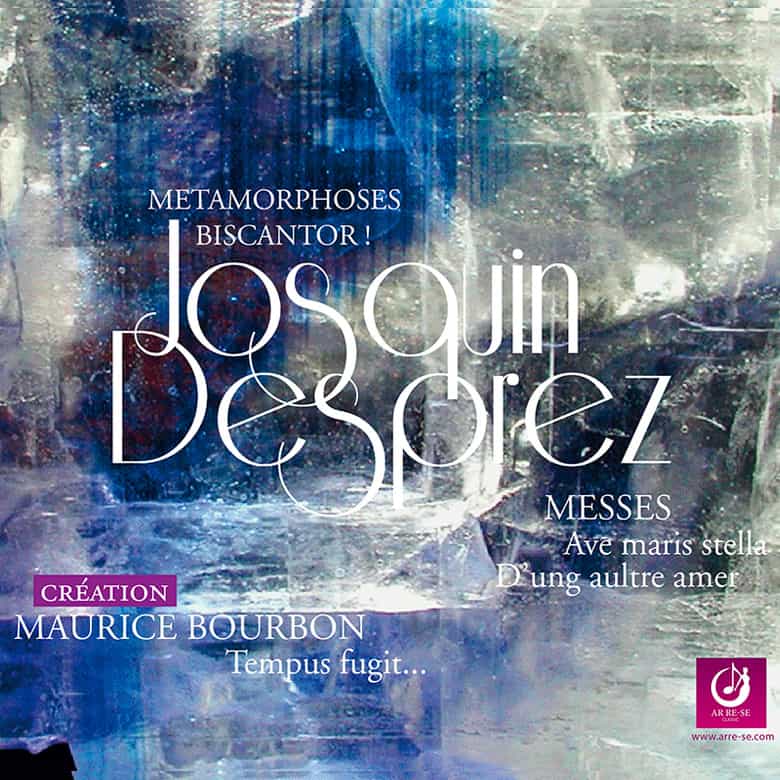Product details
Prologue
1. Prologus - Maurice Bourbon 2'13
Ave maris stellaMass
Tempus primus
Mass D'ung aultre amer
10.Kyrie 2'23
11.Gloria 2'23
12.Credo 3'51
13.Sanctus 5'18
Tempus secundus
Epilogue
14.Epilogus - Maurice Bourbon 1'03
Volume 8, "Josquin and Milan", of the complete Josquin l'Européen masses
Ensembles Biscantor! and Métamorphoses
Conducted by Juliette de Massy
AR 2020-1
3760067550302
The press speaks about it
Available in April 2020!
Initially planned with only the masses "Ave maris stella" and "D'ung aultre amer", "Josquin et Milan" (1), 8th volume of the complete masses "Josquin l'Européen", has become "Tempus fugit...".
Solicited in 2016 by the Musée Départemental de l'Isère for the opening concert of its exhibition "Les bâtisseurs d'éternité", Métamorphoses and Maurice Bourbon quite naturally combined the temporal with the spiritual dimension.
Taking advantage of the unusual form of the mass "D'ung aultre amer" and the relative brevity of the two masses, Maurice Bourbon has therefore imagined a creation by framing the magnificent works of Josquin with original compositions on texts by Agrippa d'Aubigné, Ronsard, Baudelaire and Proust, as well as a spiritual madrigal by Monteverdi. Like a wink of authors, over the centuries, to a glorious predecessor!
In the mass "Ave maris stella", the exploitation of the Gregorian hymn, taken up in its first mode essentially in the voice of the Tenor, is verified in the whole mass. The four phrases are paraphrased with a writing that favours the imitation of the motif between the different voices. Stated once in a fragmented manner in the "Kyrie", the hymn is repeated a second time in the other sections, except for the "Credo", which benefits from six occurrences, phrases that are more or less recognisable by virtue of being ornamented, varied, shortened, augmented... The Mass is written in four voices, except for the "Pleni sunt" (3), "Benedictus" and "Agnus Dei 2" (2).
The mass 'D'ung aultre amer', written entirely in four voices, is one of the composer's shortest masses, with a very nervous 'Gloria' and 'Credo' in essentially 'vertical' (homophonic) writing. The unusual 'Sanctu's', without a 'Benedictus' and with a 'Tu solus' ....', and the brevity of the mass were the triggers for the concept of the creation 'Tempus fugit...'.
"Whether in the Missa D'ung aultre amer with the example of a song by Ockeghem or by borrowing from the plainchant to construct the Missa Ave maris stella, Josquin's sound architecture is in fact in line with Leonardo da Vinci's thought and no doubt the subject of their conversations in Milan when the latter, among his many aphorisms on nature, wrote: Ciò che non ha termine [l'infinito] non ha figura alcuna.(That which has no end has no form)." (Jacques Barbier, 2019).
Maurice Bourbon called on Ronsard to evoke the passing of time in his 'Tempus secundus', the 'et tôt serons étendus sous la lame' introducing and 'setting the scene' for the magnificent Agnus 1 of the 'D'ung aultre amer'. Similarly, Agrippa d'Aubigné, in the 'Prologus' ('et rien que Dieu n'est permanent'), introduces the 'Kyrie' of the 'Ave maris stella'.
Between the two masses, a "Tempus primus" links Proust and Baudelaire, in concertante texts, then Monteverdi and his "E questa vita un lampo", finally Le Tasse and his "Morte di Clorinda". The latter is thus 'commented' by the 'Kyrie' that follows it.
Finally, the leitmotif 'nos homines', which begins the work, is a constant reminder of the human dimension of the Mass and has 'the last word' in the 'Epilogus'.
